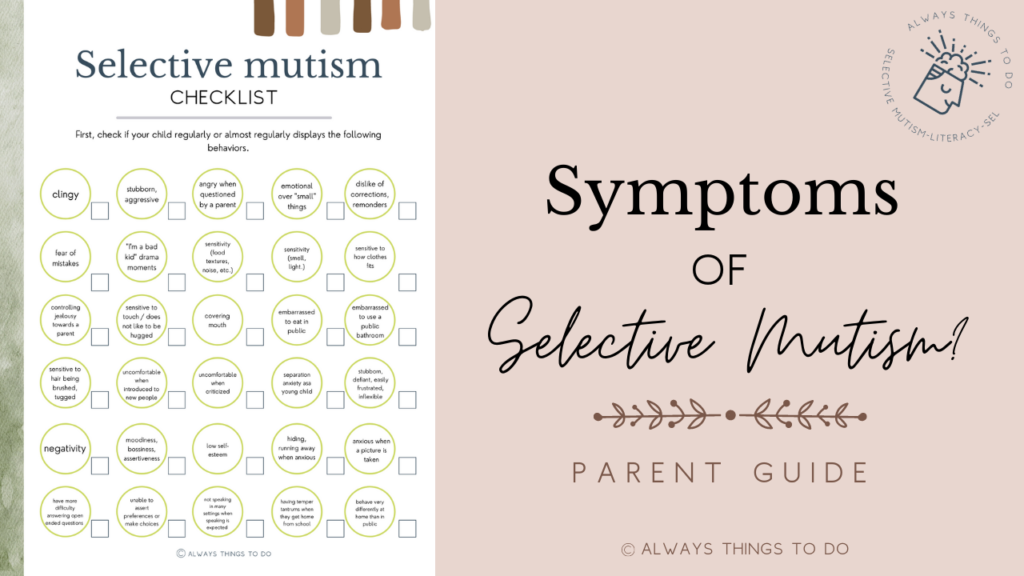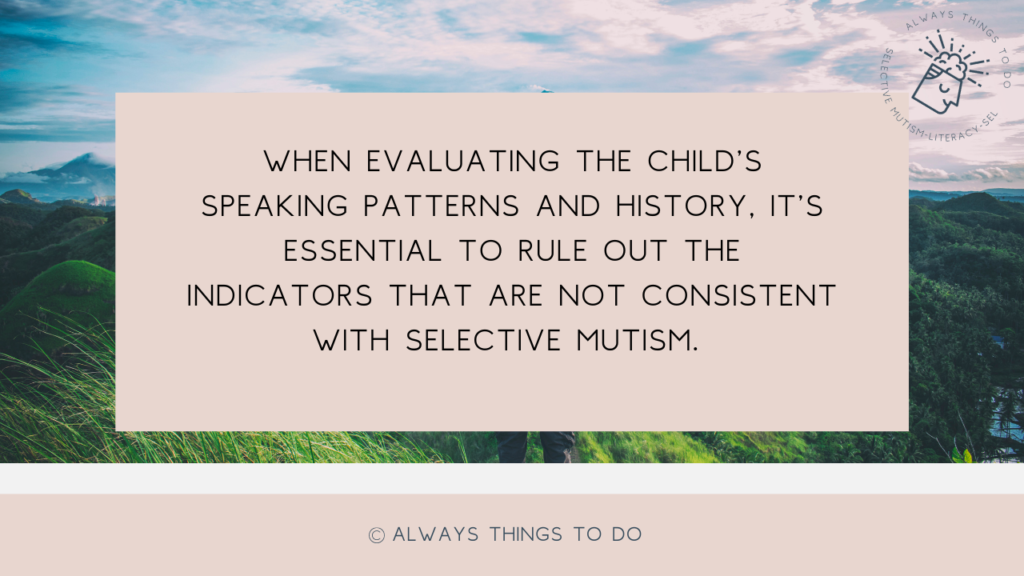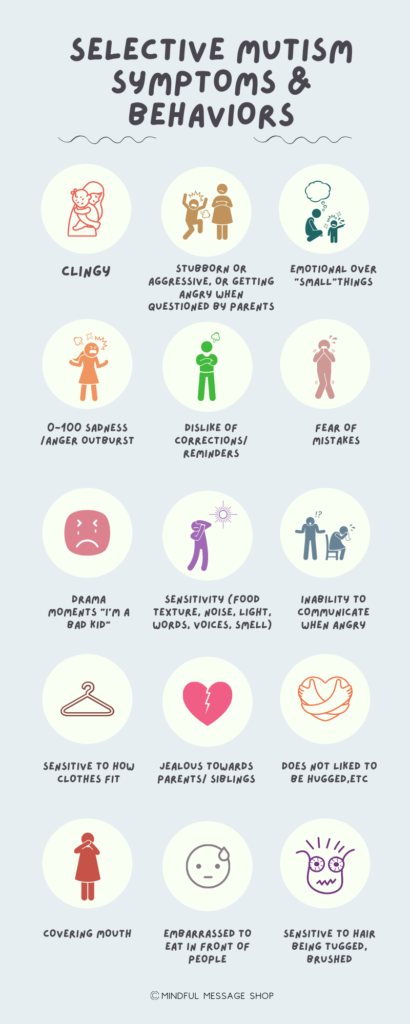70 Selective Mutism Symptoms and 3 Diagnostic Criteria.

This post will talk about:
- 70 Selective mutism symptoms and behaviors.
- 3 Diagnostic criteria for selective mutism.
- Indicators that are not consistent with selective mutism.
To anyone unaware of selective mutism (as I was four years ago), it’s almost impossible to see the signs and symptoms of this anxiety disorder in a child.
In our situation, my toddler was clingy, sometimes moody, and even bossy. She was also a picky eater and hated her hair being brushed, tugged, or any attempt of mine to put her hair in ponytails.
Before my child was diagnosed with selective mutism, nothing directly pointed to my daughter having a selective mutism anxiety disorder.
What was becoming more and more stressful, however, is my child’s tantrums and clinginess. Later, she stopped talking to her grandparents and became easily irritated by others showing affection towards me or my husband.
When a child is evaluated for selective mutism, it starts with checking off the indicators which serve as selective mutism diagnostic criteria.
Below, you will see three major ones:
- A child does not speak to peers, adults in school, and other social settings.
- A child typically speaks in a home or comfortable setting but shuts down (stops talking) when someone (the child does not talk to) approaches a child.
- A child displays a consistent pattern of not speaking to other people, which stretches beyond the “warming-up” period during the first months of school.
Children with selective mutism may display other behaviors typical to selective mutism, but they may not serve as diagnostic criteria.
There are some selective mutism symptoms and behaviors that children may display:
A printable version of selective mutism symptoms and behaviors is here.
- 0 to 100 sadness, anger outbursts
- Angry when questioned by parents
- Anxious when a picture is taken
- Appearing “frozen” when uncomfortable
- Assertive and domineering behavior at home
- Awkward body language
- Behaving very differently at home than in public
- Being able to nod or gesture only
- Being unable to assert preferences or make choices
- Being unable to eat at school and/or in public
- Being unable to use the bathroom in public
- Being uncomfortable to be introduced, teased, or criticized
- Bossiness
- Clinginess to caregivers
- Compulsive traits
- Constipation
- Covering mouth
- Defiance
- Depressive
- Disliking corrections and reminders
- Disobedience
- He does not like to be hugged, etc.
- Drama moments “I’m a bad kid…”
- Easily frustrated
- Easily frustrated by school work
- Embarrassed when eating in front of people
- Emotional over small things
- Excessively shy
- Eye contact avoidance
- Fear of embarrassment in front of a group
- Fear of mistakes
- Fear of people
- Fear to make mistakes
- Fidgeting
- Having more difficulty answering open-ended questions
- Having temper tantrums when they get home from school
- Having trouble initiating speech or gestures
- Inability to speak in school and other specific social situations
- Inflexible
- Jealous towards parents/siblings
- Lack of eye contact when feeling anxious
- Lacking movement or expression when in feared situations
- Low self-esteem
- Mood swings
- Negativity
- Not be able to ask for help if hurt, lost, or need to use the restroom
- Not being able to respond in a group setting
- Oppositional
- Perfectionism
- Picky eater
- Potty problems
- Reluctance to speak between 2 and 4 years of age
- Rude or sulky
- Running away, hiding when anxious
- Sensitive to hair being tugged, brushed
- Sensitive to how clothes fit
- Sensitivity to food texture, noise, light, voices, smell)
- Sensitivity to sound
- Sensitivity to touch (hair brushing, hair tugging)
- Separation anxiety
- Shy and withdrawn
- Socially awkwardness, nervousness, uneasiness
- Speaking easily in certain situations (usually home), but not others (usually at school)
- Stiff
- Stubborn
- Temper tantrums
- Tense
- Timidness
- Using nonverbal communication to express needs
- Using whispering or alternative voice (baby, singing) when anxious
Selective mutism is an anxiety disorder that impacts a child’s ability to speak in some social settings and with some people.
It should be noted that there are many reasons a child may not speak.

When evaluating the child’s speaking patterns and history, it’s essential to rule out the indicators that are not consistent with selective mutism.
Below, there are some of them:
- a child has limited speaking in ALL the settings
- a child’s speaking habits are INCONSISTENT (a child speaks to teacher sometimes)
- a child does not talk at all
- a child suddenly stops speaking in a particular setting due to bullying, criticism, etc.)
- a child stopped speaking after a trauma
- a child has some other issues with speech and language development
Proper diagnosis of selective mutism based on the diagnostic criteria and identification of any other possible conditions/ disabilities accompanying selective mutism are essential in designing adequate treatment with the selective mutism professional and interventions at school.
If you liked the information in this post, make sure you explore other posts about selective mutism:
- “What Is Selective Mutism?”
- “Selective Mutism: How To Beat Crisis, Screaming, and Fear.”
- Diagnosis of Selective Mutism: Simple Parent Guide and Steps to Take.
- What Are The Causes of Selective Mutism?
- Is Selective Mutism a Disability?
- How Do You Treat Selective Mutism?
Check out the expanding library of tools. Go to the selective mutism page and scroll to the bottom section, “Latest Projects.”
Connect with me on social media @alwaysthingstodo.





2 Comments
Pingback:
Pingback: